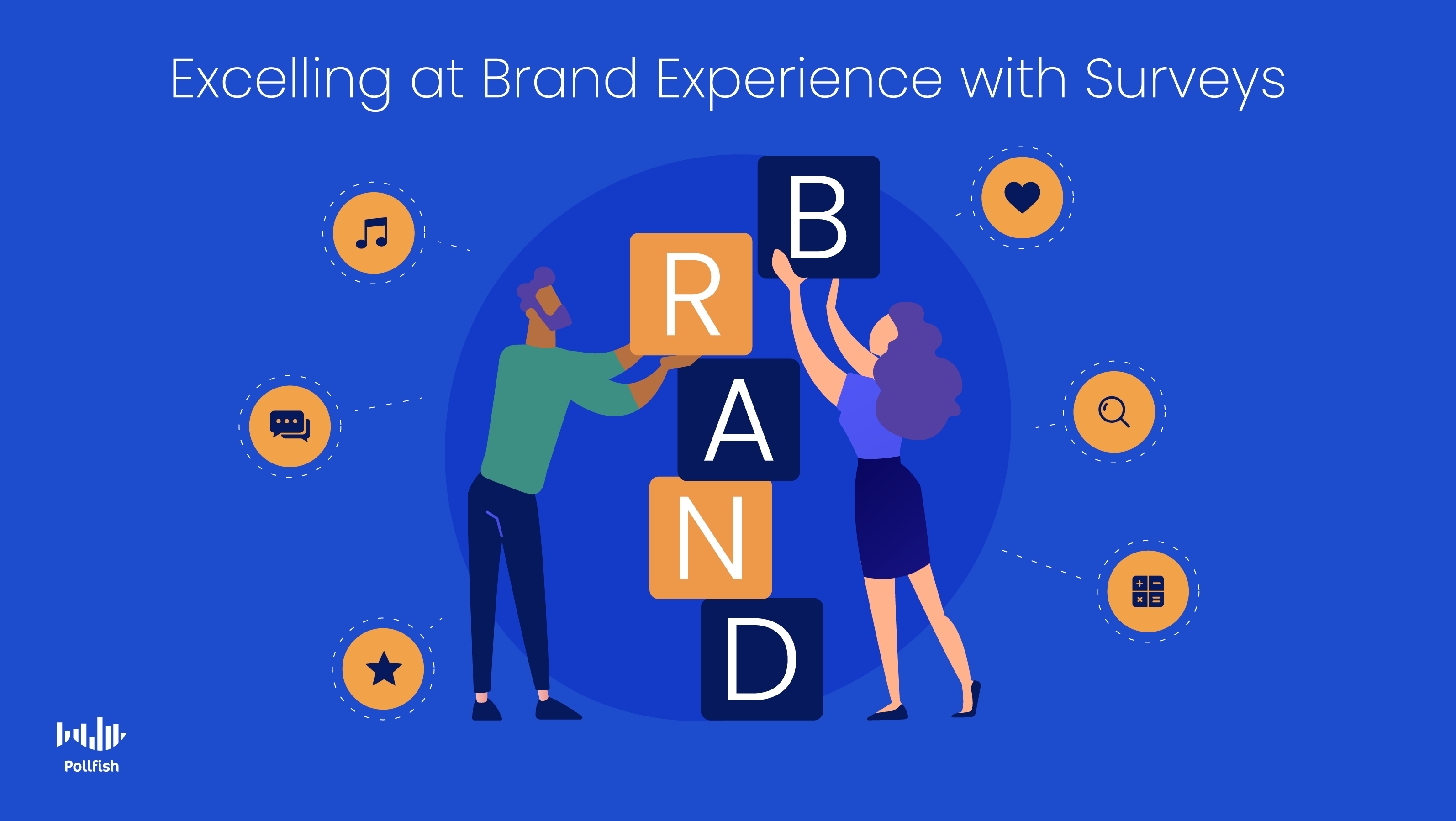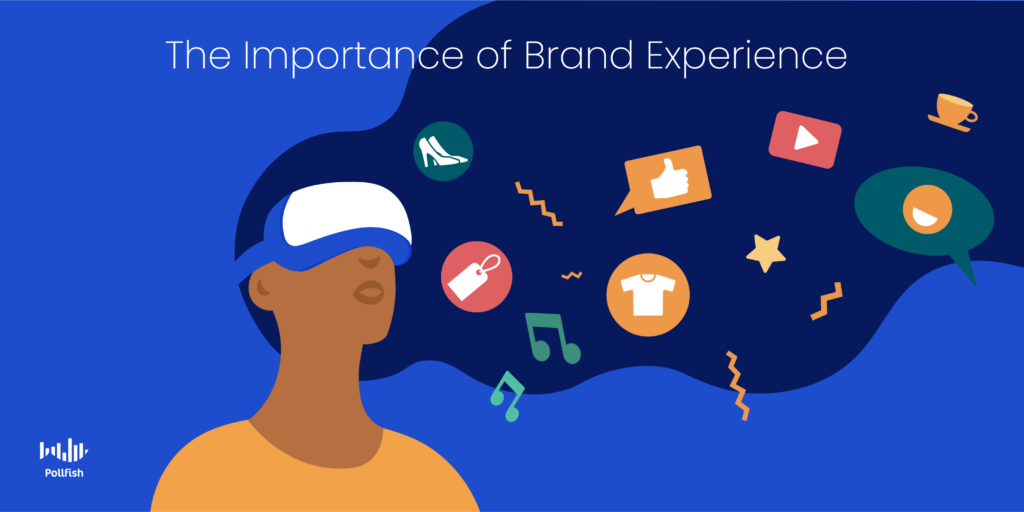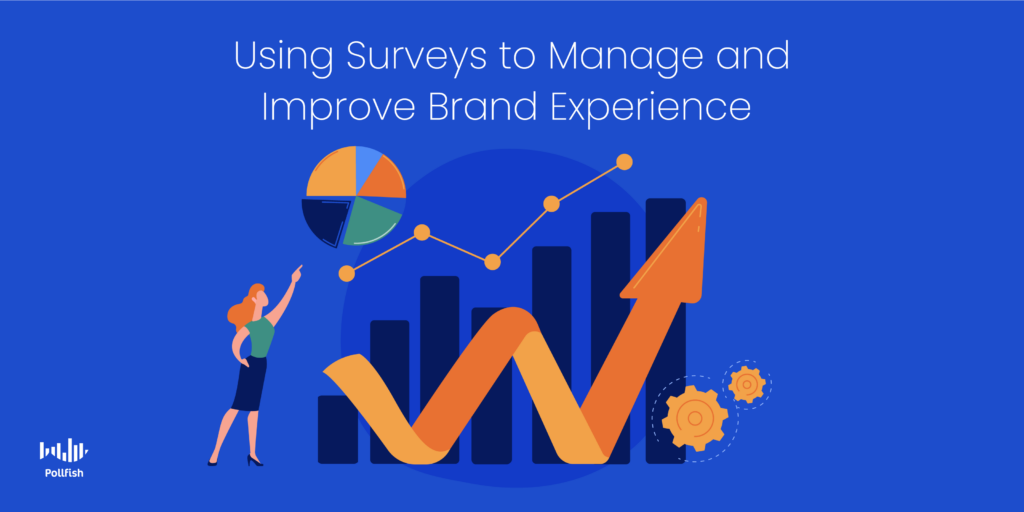Managing and Improving Brand Experience with Surveys

At the heart of every brand lies its brand experience, which not only helps a business obtain its key differentiating factor(s), but is largely responsible for customers’ associations and feelings towards a brand.
This concept also plays a crucial role in brand visibility and brand equity, as it is the experience that shapes visibility and defines a brand’s value for its customers. Experience-driven businesses see a 1.5 times higher YoY growth than other companies.
In addition, brand experience dictates the way customers share their experiences with others. This is important, as customers make both their good and bad experiences publicly known, such as on social media, forums, review sites and via word-of-mouth.
72% of customers will share a positive experience with 6 or more people. Unsatisfied customers, on the other hand, will share their experience with 15 or more people. To satisfy customers, brands must create consistent brand experiences in an omnichannel setting.
This article explains brand experience, its importance, several examples, how it differs from user experience (UX) and how to manage it and improve it with surveys.
Understanding Brand Experience
This concept is defined by the sum of all thoughts, feelings, reactions and sensations that consumers undergo in response to a brand. Brand experience is not exclusive to a particular channel or media type.
Rather, this is the result or the lasting impression that remains with customers after they’ve either encountered or engaged with a brand in any capacity.
Brand experience is a holistic set of conditions that a company creates to influence how customers perceive a particular product or the brand itself. Given that this involves interacting with customers to influence their feelings, it is also considered a kind of experiential marketing.
Companies form their brand experience through a combination of interactions with customers, whether they are digital, physical (such as with products) or in-person (in-store shopping, events, etc). Through different modes of communication, brands can create a positive atmosphere, so that customers establish a tie between the brand and an emotion or need.
As such, brand experience involves creating sensory user experiences so that they can long resonate with customers. This tactic of engagement facilitates brands to convert their brand awareness into brand loyalty.
The Importance of Brand Experience
Brand experience carries plenty of importance for businesses of all sizes and there they’re startups or long-established companies. Firstly, this concept deals heavily with creating positive experiences, the kinds that make all members of a target market remain interested in a company, impressed by how it made them feel.
Since brands are competing on experience, a good product or service alone is not enough to retain customers anymore. Thus, brands need to hone in on their brand experience to truly set themselves apart from competitors. This involves forming experiences that can reasonably be seen as superior to competitors’.

Given that a brand is often expressed as a network of associations living within customers’ minds, brands must foster strong brand experiences so that their consumers continuously view them in a positive light. These associations help businesses and market researchers assess customer perceptions, the relevance of their brand, preferences and whether their marketing campaigns are working.
The notion of brand experience also helps brands forge connections with customers, as experiences can humanize a company, show customers that it is more than just a money-making machine and encourage companies to spend more time with their customers. It therefore makes a brand far more present in the lives of its customers than it would have been had it not involved brand experience in its strategy.
A positive brand experience can inspire customers to make changes to their lifestyle and habits, the kinds that involve buying products from a particular brand. A brand experience can inspire customers to create their own content based on their use of a brand’s product or their experience with one. This creates testimonial-like assets for brands, which they can use in their marketing collateral and social media campaigns.
When businesses provide a positive brand experience, this can be the ultimate deciding factor for customers to choose one brand over another. In fact, brands with superior experiences yield 5.7 times more revenue than companies lagging in brand experience.
This should come as no surprise, given that a strong brand experience spurs repeat purchases, one of the underlying aspects of customer retention. When brands retain their customers, those customers in turn, increase their customer lifetime value by bringing more continuous value to a business.
As such, this concept largely affects customer buying behavior, having the power to steer it in one way or another.
Examples of Brand Experience
There are several factors that form brand experience in its entirety. That’s because various aspects of a customer buying journey influence the way customers view a brand.
The following presents common examples of brand experience aspects:
- Customer service can give customers a positive view of their brand experience and make them likely to purchase or return to a brand.
- A strong digital experience allows companies to create their brand’s online presence through their websites, social media, blogs and mobile apps.
- Promotions such as discounts, coupons and customer loyalty programs bring in new customers and create positive experiences.
- Advertisements that target specific customer personas or a broader audience are an extension of a brand’s personality and feelings associated with it.
- Branding aspects like logos, store layouts and signage designed to involve emotions, via emotional marketing like trust, excitement, or dependability.
- Slogans and jingles that are unique to a brand.
- Community participation, such as physical stores, expressing certain views, addressing regional holidays, etc.
- Content marketing campaigns such as blogs, newsletters, resources, infographics, mobile experiences to mold perceptions of a brand.
- Design aspects such as color schemes for ads, web content, and other marketing collateral to stir up desired feelings in customers.
- Product placement and influencer marketing that disseminates products through different media outlets such as social media, film, commercials, etc., to encourage customers to use their brand.
Brand Experience Vs User Experience
Although these terms may be used interchangeably, they are different concepts that therefore have many differences despite their similarities. While both of these concepts entail the sensory, cognitive and behavioral responses that customers face in response to an experience with a company, there are several distinctions between them.
User experience specifically deals with a customer’s takeaway from their interaction with a brand’s products, services, workers, digital experience or other offerings. For example, a good UX occurs when customers have a positive user experience in the following scenarios:
- Receiving fast and effective customer service
- An easy to navigate website
- A smooth checkout process
- A workable product
Brand experience, on the other hand, is all about communicating a vision and feelings to users, which includes catering to them even before they become a user. Therefore, it heavily relies on design and messaging to communicate specific things that make users feel a particular way about a brand.
User experience deals with the experiences that users have already undergone. It also involves the customer journeys that customers must go through to reach their ultimate destination with a brand.
Although these concepts are different and involve using different methods to uphold, you can’t have one without the other. A positive UX helps foster positive brand experiences. Consider this: when a customer has a positive user experience with a brand’s website or app, this experience influences the way they’ll view the brand behind it.
As such, a user experience should implement a consistent brand voice and other branding elements throughout. If it doesn’t, it will be difficult for customers to recognize the brand behind the experience.
Managing and Improving Brand Experience with Surveys
With the diverse makeup of brand experience, it can appear to be difficult to manage, let alone optimize. Surveys are critical tools to use for various market research purposes, along with marketing purposes such as brand experience.
Brands can manage their BX (brand experience) by first being pointedly aware of their customers, which includes a wide swath of considerations, such as: user experience, customer preferences, expectations, desires, aversions, needs, behaviors, opinions and more.
 This is because surveys can be used to examine virtually any subject by strategically setting up the questionnaire with the 6 main types of survey questions, depending on the capabilities of the online survey platform they use. They can also incorporate different elements into the questions to maximize respondent engagement, such as videos, GIFs, images and more.
This is because surveys can be used to examine virtually any subject by strategically setting up the questionnaire with the 6 main types of survey questions, depending on the capabilities of the online survey platform they use. They can also incorporate different elements into the questions to maximize respondent engagement, such as videos, GIFs, images and more.
Surveys should therefore be used as a data-driven tool to plan and execute brand experience campaigns. However, they provide even more utility than simply understanding customers to improve BX campaigns.
This is because, when a brand explicitly mentions itself in a survey, this tactic creates a brand experience on its own, raising brand awareness and granting respondents a chance to interact with the brand in a unique way. As such, a brand can improve its brand experience with surveys as another avenue for doing so. To this end, brands can also use multiple question types, add multimedia to questions, personalize the questions, as marketing personalization is key to BX, incentivize the survey and more — all while associating the survey and its positive attributes with a brand.
Going Above and Beyond for Your Brand
Making headway in any branding activity requires being prepared and using a data-driven approach that justifies strategies and a plan of action. After all, no business wants to see their time, resources and efforts go to waste.
That’s why all brands need to conduct market research; survey research in particular, is crucial to implement, as it equips brands with the most relevant and granular insights on their niche and target market. This is because market researchers can set up their surveys in their manner of choice and ask any questions they seek. Best of all, they can acquire answers from the respondents that matter the most — their customers.
Equally important to using surveys if not more so, is choosing the correct online survey platform to create and deploy the surveys. Businesses should choose an online survey platform that allows them to hyper-target their survey respondents, set quotas and use advanced skip logic to route users to the proper follow-up questions.
Additionally, a strong online survey tool allows brands to create quality data checks via artificial intelligence and machine learning, use a wide range of filtering data options, engage respondents in their natural digital environments via random device engagement (RDE) sampling and much more.
A business that uses such survey software is well-adjusted and prepared to tackle a wide range of marketing and market research campaigns, including improving its brand experience.
Pollfish Marketing Team
Ready to Try Pollfish?
Create your survey with AI, target high-quality respondents starting at $0.95 per complete, and start getting results in just minutes in real-time. From running a simple product concept survey to managing a constant stream of trackers for dozens of clients in dozens of countries, we’ve got you.
